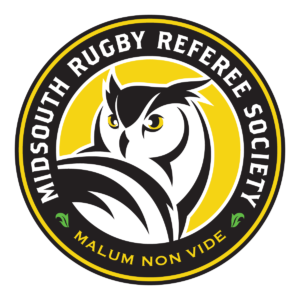A C1 referee should be able to manage all items outlined for C2 as well as those aspects of the game that relate to offside. He should be able to manage the participants arriving after a tackle, but he may have problems ensuring the ball is immediately available. He should provide concise and specific explanations for penalties that are clearly understood by players. He should be fit and in proper position for all aspects of play with the possible exception of faster-paced tackle situations. He should be confident in his management of the players, and he should establish clear priorities for the players. TACKLE
- All elements listed for C2 and C3.
- Observed flagrant killing of the ball by tackler and ball carrier.
- Observed players lying on the ground interfering with ball availability.
- Observed players lying on the ground interfering players on their feet.
ADVANTAGE
- All elements listed for C2 and C3.
- Played advantage with consideration of players’ safety.
- Played advantage in all appropriate situations.
- Communicated the type of infringement and the team that offended while indicating that advantage is being played (e.g., “Blue advantage, penalty” or “Blue advantage, scrum”).
RUCK/MAUL
- All elements listed for C2 and C3.
- Observed players who failed to remain on their feet.
- Observed flagrant use of hands to win the ball.
- Observed players who obstructed in advance of the ball (“truck and trailer”).
- Observed defenders who unbound and affected play.
- Observed offside by defending non-participants, including loiterers.
RESTART KICKS & OPEN PLAY
- All elements listed for C2 and C3.
- Proactively prevented offenses at static restart kicks from occurring.
- Observed players lying on the ground (Law 14) interfering with ball availability.
- Observed players falling over a player on the ground with the ball.
- Observed offside players in open play when ball was kicked ahead.
- Recognized willful knock-ons.
SCRUM
- All elements listed for C2 and C3.
- Observed and ensured binding between opposing props was correct.
- Observed and ensured that heads and shoulders were above the hips until the scrum was over.
- Observed and ensured that the body and feet of all front row players were in a normal position to make a forward shove.
- Did not have repeated reset of scrums. In other words, the problems causing reset scrums were identified and solved.
- Ensured back rows remained bound until the scrum was over.
- Ensured non-participants remained onside.
LINEOUT
- All elements listed for C2 and C3.
- Ensured jumpers did not jump early or remain supported in the air prior to the throw-in.
- Ensured there were no destructive offenses across the lineout.
- Ensured participants remained onside.
- Ensured proper support of jumpers.
- Ensured non-participants remained onside when ball is held in the lineout.
- Managed quick throw-ins.
CONTROL
- All elements listed for C2 and C3.
- Observed late or early tackles on passers.
- Observed obstruction.
- Observed use of a teammate as a “pick” or shield.
- Observed unfair play and applied the appropriate punitive measures.
- Observed dangerous play and misconduct and applied the appropriate punitive measures.
- Used appropriate punitive measures.
- Communicated with captains/players so that they complied with his requests upon formal prompting (i.e., players were compelled to comply).
- Remained calm in tense situations.
COMMUNICATION
- All elements listed for C2 and C3.
- Secondary signal was clear and given simultaneously with verbal explanations promptly after the whistle was blown.
- Explanation for penalty was concise, specific and clearly understood by players.
